![]()
![]()
![]()
Use LEFT and RIGHT arrow keys to navigate between flashcards;
Use UP and DOWN arrow keys to flip the card;
H to show hint;
A reads text to speech;
98 Cards in this Set
- Front
- Back
|
What are carbonate platforms? |
Thick sequences of shell-water carbonates - Generally form on passive margins or intracratonic basins - Often several km thick |
|
|
In which ways do reefs grow? |
Reefs grow upwards (towards light) and outwards (to maximize surface area) - accumulation is tied to the health of the system |
|
|
Rimmed Platform |
There is some kind of barrier separating the reef from the rest of the ocean Isolation results in less wave energy travelling to the middle of the platform - Sedimentation into the deep is due to turbidity currents (high slope)
|
|
|
Epieric Platforms |
Very large (100s of kms wide) Cratons flooded by high SL usually shallow but can have deeper sub basins |
|
|
Isolated Platforms |
Isolated from terrigenous sediment i.e, the Gulf Stream separates the Bahamas from North America Height is a result of reefal system building upwards
Platform interior will be muddy - all coarse grained material will be transported down the shelf into the ABYSS |
|
|
Fringing Reefs |
Welded on to shoreline - no backreef area |
|
|
Atolls |
Form in subsiding volcanoes like a ring reef |
|
|
The health of carbonate systems depend on what three factors? |
1. Oceanography 2. Climate 3. Organism biology |
|
|
What are features of an ideal carbonate system? |
- Low suspended sediment - Medium salinity - Temperature stable around 18 or 25-29 deg |
|
|
What is water flow like around an unrimmed shelf? A rimmed shelf? What may be a problem for rimmed shelves (in terms of water circulation) |
an unrimmed shelf has free circulation as there are no barriers a rimmed shelf may have barriers for circulation - can become stagnant if SL regresses a tiny bit below barrier |
|
|
Why are tectonics important for carbonate systems? |
Since carbonate systems take so long to grow, they would generally only be established on passive margins. Tectonics also controls the rate and amount of subsidence, denoting the nature of the reef |
|
|
Roughly how far does light penetrate (the photic zone) in an ocean? |
70 m |
|
|
What is the difference between the morphology of a reef and a mound? |
Reef: Large clonal elements usually larger than 5cm, capable of thriving in high energy environments.
Mound: built by smaller delicate solitary elements in tranquil settings - baffles + traps sediments like stromatolites |
|
|
Bioherm |
Lens shaped reef or mound (think of Dev bioherm from Wainfleet quarry) |
|
|
Biostrome |
tabular rocky body |
|
|
Reef growth is a delicate balance between: |
1. Organic growth (corals) 2. Sedimentation (algae, skeletons) 3. Destruction (raspers, borers) |
|
|
How does the morphology of organisms change as we increase wave energy in a reef system? |
Lowest energy = branchers, platy corals Medium energy= branchers, massive, globular |
|
|
What is autostratigraphy? |
The automatic succession of reef systems - This is the stratigraphy you see as a reef naturally grows - Sediments accumulate through lateral/ vertical accretion
Vertical accretion because reef organisms are photosynthetic- shallowing upwards to grow towards light
Lateral accretion when there is no more vertical space
|
|
|
What are factors that may contribute to shutting down a reef system? |
1. Air/ water exposure 2. Base of photic zone is reached (no light left) 3. Base of wave abrasion reached (no wave energy/ circulation... recall what can happen to rimmed shelves) 4. Anoxic environment 5. Thermocline (water too warm or cold) 6. pycnocline (too much salinity) |
|
|
Provided ambient ocean conditions are ideal, what is the mean rate of carbonate production in reefs? |
1.5-4.5 kg or CaCO3/year |
|
|
What increases through time on a reef system? |
1. biodiversity 2. biomass 3. structural complexity and stability |
|
|
What are the successional stages of autostratigraphy and their associated rock types? |
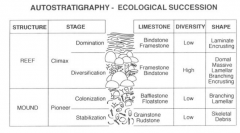
1. Stabilization 2. Colonization 3. Diversification 4. Domination
|
|
|
What are the characteristics of Pioneer (R selected) species? |
- Live fast die young - Have lots of bebies - Usually the first species to colonize an area - Can tolerate harsh environments - poor competitive ability |
|
|
Late succession (K selected) species? |
Produce fewer, larger young (put more investment into them as well) - Usually arrive at site later (may require pioneers to moderate environment) - Slower growth, longer time to get sexxii Long living good at competition (displace pioneers) |
|
|
What is allostratigraphy a function of? |
1. Varying conditions in the growth window 2. Ecological succession 3. antecedent topography 4. SL rise and organism growth |
|
|
Growth of reefs upwards is characterized by what? What is the avg growth potential of modern reefs? |
1. subsidence 2. eustacy 3. sedimentation
Modern growth potential = 100 cm/KY
|
|
|
What are three growth situations of reef systems? |
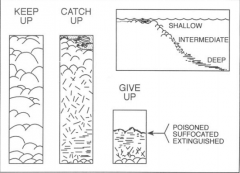
1. Keep-up: reef is growing, SL is rising at the same rate. Maintains crests at or near SL 3. Give up: reef smothered by sediment, nutrient excess, and no more light
|
|
|
Cnidaria |
Late proterozoic to recent - Sessile, planktic, nektic - Solitary/ colonial - external/internal skeleton - Corals, sea anemonies, jellyfish, hydrozoa, Primary radial symmetry |
|
|
Coral/anemone polyps |
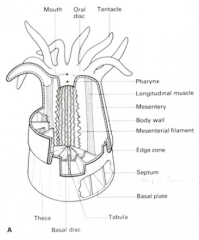
Ciliated pharynx with a tube extending into the enteron (tummy) - radiating vertical partitions= mesantries (attatch the body wall to the polyp and oral disk
|
|
|
Anthozoa |
Marine only - solitary/ colonial - Corals, anemones, gorgonians, sea pens Only free swimming larva mostly sessile Skeletons are internal/ external
|
|
|
What are true corals? |
members of the class anthozoa that secrete massive CaCO3 skeletons - divisions are according to number and arrangement of mesantries
calcareous cones/ cylinders Upper part occupied by living polyp |
|
|
What is a corallum |
One coral unit (solitary or colonial) |
|
|
What is a corallite |
any one polyp in a community |
|
|
Rugose corals |
dominant in mid silurian- Triassic calcite solitary/ colonial Bilateral symmetry prominent septa
sediment baffler |
|
|
Why are rugose corals particularly sensitive to environmental change? |
They stick into the substrate like little horn tips (not very stable) - Any moderate-high wave action or anything bumping against it would likely topple it over
*this is why we see some rugose corals that are very curvy; they fall over and then start growing towards the sun again |
|
|
Tabulate corals |
Always colonial Abundant Ordovician-Silurian, extinct at Permian calcite structure small corallites |
|
|
Ceriod |
polygonal corallites all in contact |
|
|
Cateniform |
elongated corallites joined end to end in wandering palisades |
|
|
Fasciculate |
cylindrical corallites with connecting tubules |
|
|
Porifera |
Simplest and one of the oldest living organisms - no nervous system Sedentery filter feeders needle spicules of CaCO3 (what gets preserved as chert nodules after they lithify) |
|
|
Where are sponges found? |
Aqueous environments marine/fresh polar/tropical shallow-abyssal sessile/benthic
*clionas can burrow into calcareous substrate |
|
|
Stromatoporoids |
Not sure if they're sponges or not - Calcareous masses of layered/ structured material Cambrian-Cretaceous (Dominant Sil-Dev)
Important framework builders |
|
|
Conodonts |
likely the tooth of some early toothy fishy |
|
|
Bryozoans |
Ordovician-Recent Sessile colonies of connected zooids Mostly marine filter feeders Shallow shelf-abyssal Branching/encrusting forms
Frame builders/ sediment binders over time commonly bridge gaps in coral structures to allow for hard surface over time |
|
|
What does the morphology of bryozoans indicate? |
Proportions of rigid/ branching forms increase with depth Encrusters in shallow water, high energy
Delicate branchers are likely behind reef front or below wave base |
|
|
Graptolites |
marine colonial filter feeders very yummy to eat (therefore they are generally only preserved in dark anoxic muds where nothing could get at them after they had died + floated down)
Very useful lower paleozoic biostratigraphic marker
planktic/benthic |
|
|
Echinodermata |
Important sediment producer (rasping beak, also fragile skeletons) Very diverse benthic filter feeders Internal mesodermal skeleton - Covered with velvet like skin and spines
Pentameral symmetry |
|
|
Brachiopods |
hinged like bivalve filter feeder (lophophore) symmetrical in the middle (bilateral)
Fixed to seafloor with pedacle Cambrian appearance, less so in Meso
most common shallow water taxa some may have been infaunal, some epifaunal |
|
|
Arthropoda |
an "unreal entity" consisting of a mish mash of different elements - insects, crustaceans, spiders,
hard exoskeleton biased fossil record |
|
|
Trilobite |
great biostratigraphic marker generally mobile benthic but some may have been pelagic/ shallow infaunal big bioturbators |
|
|
Receptaculites |
Green algae mats Ordovician-Permian Large framework component shallow water (psynth) |
|
|
Stromatolites |
Sheet like mats and domed build ups of marine microbes - trap and baffle sediment form mounds called stromatolites only found in harsh environments today
dominant reef builder in Precambrian, reduced in Paleo cause of eaters |
|
|
Echinozoa |
sub-phylum of echinodermata globose (sea biscuit) or discoid (sand $)
Mouth internally located with rasping beak
simple nervous system - not very fast - water controlled pseudofeet for locomotion |
|
|
Mollusca what are the classes? |
one of the most diverse phyla marine/ freshwater
Monoplacophera: marine with univalved limpet shell
Amphineura: benthic marine, slow moving with a radula (i.e, chiton)
Sacphopoda: marine with small tapering + slightly curved shell infaunal-subtidal
Rostroconcha: extinct
|
|
|
Bivalves |
Pair of unequilateral hinged valves abundant shallow-abyssal marine/benthic infaunal/epifaunal
|
|
|
Gastropoda |
Largest class of mollusc apx 100,000 living species all land/ sea snails periostracum= outer horny layer inside aragonitic nacreous inside |
|
|
Cephalopods |
only marine highly evolved mollusc (supa smert) nautilis, octopus, squid nektic-benthic carnivores |
|
|
Nautilus |
known as a living fossil gas filled chambers, swims via propulsion aragonitic shell
*only cephalopod today with an external shell
|
|
|
Orthocones |
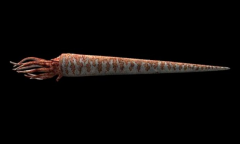
appear in Late Cambrian-Silurian Lasted to late Triassic |
|
|
Ammonites |
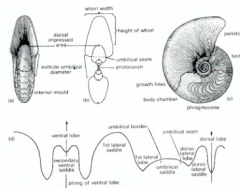
Great biostratigraphic markers (Triassic-Cretaceous) due to rapid evolution + wide distribution
planispiral
|
|
|
T/F: 3. Serpenticone ammonites may have been benthic 4. Why did uncoiled ammonites likely float vertically in the water? |
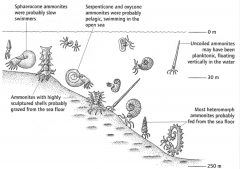
1. Nope, they probably swam slowly b/c they were spheres 3. No! They were probably pelagic like modern day nautilus 4. The shape of their cone shape
|
|
|
Hydrozoa |
Cnidaria - Fire corals (not true corals) - had small stinging cells - lived on fore reef (important framework builder) - CaCO3 skeletons Marine |
|
|
Anthozoa/ Gorgonian |

Sea fans - poorly known as fossils (probably because they're so delicate) - Flat fan on anastomizing branches |
|
|
Scleratinian Corals |
Phylum Cnidaria, class Anthozoa everything post Triassic All have aragonitic exoskeleton The skeleton of an individual polyp is a corallite Ahermatypic does not contain this algae (some are carnivorous/ filterfeeders) |
|
|
Hermatypic Corals |
Shallow tropical waters -25-29 deg and up to 90 - High temperatures cause corals to barf out their symbiotic algae. This is known as coral bleaching
Normal salinity, no mud - can grow to large sizes Require water movement |
|
|
Ahermatypic corals |
Found at depths of up to 6km most abundant up to 500m - temp 5-10 deg
2/3 solitary form coppice colonies |
|
|
Algae |
Simple psynth tiny plants - single/multi celled
- less than 10% can calcify - those that to are important sediment producers
|
|
|
Rhodophyta |
Colours: pink/red, purple, yellow,blue, white, green Coralline algae - an form crusts on most things - crustose frameworks
Wide temperature range High energy environments (strong walls) - High energy keeps away grazers
Moderate framework builder/ sediment contributer |
|
|
Calcareous Algae |
Plantae/Chlorophyta/Bryopsidophyceae /Bryopsidales/ Halimedacae
green in colour (chlorophyll) - varied shaped, rooted to substrate in back reef/ lagoon areas
big sediment producer
|
|
|
Serpulid worms |
Sessile CaCO3 tube building worms sometimes confused with vermetid gastropods
Serpulids are dull inside and gastropods have a nacreous inside |
|
|
Foraminifera |
single celled animals form a CaCO3 shell planktic benthic
big chalk producers
great biostratigraphic markers as they are very abundant and alot of them are dependent on the environment they formed in |
|
|
Homotrema rubum |
red coloured encrusting foram grows on lower surfaces of shells + corals
Encrusting/ branching forms |
|
|
Coccolithophores |
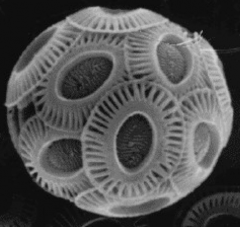
unicellular planktonic protists living in upper water column Important in Triassic outer shell made up of small plates called coccoliths
accumulate in deep basin and contribute to chalk
|
|
|
Ostracodes |
benthic/pelagic chitinous carapace marine forms burrow (infaunal)
freshwater ones float |
|
|
What is the difference between autostratigraphy and allostratigraphy? |
Auto= ecological succession (how does the reef build up as it grows?) Allo= environmental controls on growth |
|
|
What makes a fossil particularly good for biostratigraphy? |
1. Small size 2. Wide distribution 3. constrained timescale 4. large abundance |
|
|
Micrite |
Super fine carbonate mud - form matrix of limestone
|
|
|
Sparite |
sparry calcite - looks rainbowey/ white in thin section - |
|
|
Platform area and Dunham Rock type |
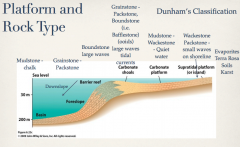
|
|
|
What is the total thickness of the Bahama carbonate bank? |
>4500m (almost 5km!!) |
|
|
why are karstic surfaces important SL indicators? |
karst surfaces can represent the ancient buildup of a reef as SL rises, and the termination of the carbonate factory once SL starts to lower |
|
|
At what marine isotope stage (MIS) was SL the highest? |
MIS 5e |
|
|
What is a stadial vs. an interstadial? |
stadial= cool period interstadial = warm periods |
|
|
How many glacial-interglacial stages have there been over the past 0.8 million years?? |
8, each lasting ~100,000 y |
|
|
What is karst? |
A landscape with high rock solubility and well developed secondary porosity
features include sinkholes, caves, |
|
|
Cave |
cavernous underground area either above water table (vadose zone) or below (phreatic) |
|
|
How does karst form? |
form from the dissolution of limestone bedrock - major contributors include carbonic acid -minor contributors include humic acid |
|
|
What is the difference between the vadose and phreatic zones? |
Vadose= above water table, water flows in underground rivers (and incises channels underground)
|
|
|
How do caves form underground? |
preferential dissolution along bedding planes |
|
|
What are peritidal environments? |
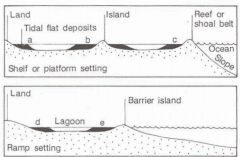
low energy tidal environments - occur in protected areas along shorelines - Tidal channels may be extensive -major processes include progradation and channel migration |
|
|
Mangrove |
salt tolerant tree that grows in intertidal areas on tropical shores, or islands |
|
|
What are ichnospecies |
trace fossils like a burrow |
|
|
Ocypode |
ghost crabs - inhabit sandy beaches just above the water line - spend the day in spiral burrows, come out at night
|
|
|
Callianassa |
burrowing shrimp found in intertidal-tidal zones burows into sandy substrates
big bioturbator: large abundance and large size and high activity |
|
|
Skolithos |
Trace fossil is long like a worm |
|
|
How do trace fossils (ichnofacies) change on different beach zones? |
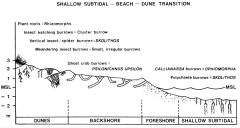
|
|
|
Tidal channel facies |
progradation characterized by shallowing upwards sequences |
|
|
coral algal facies |
skeletal debris/ high wave energy - platform margins
|

